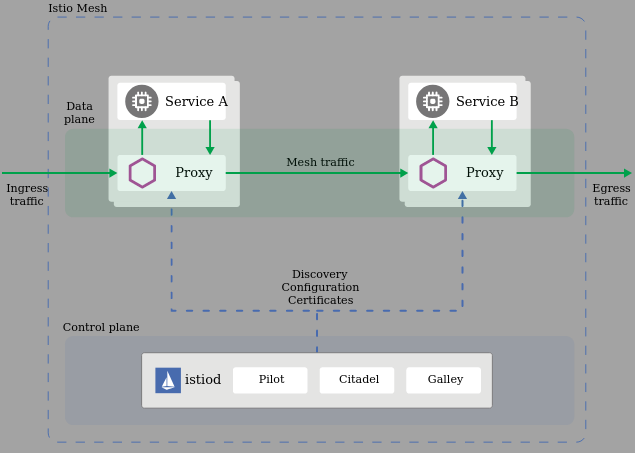Kubernetes/Istio
Architecture Istio v1.7
Namespace: <app namespace> | app1 | | app2 | # main container | proxy | <----------> | proxy | # Data Plane (all Envoy sidecar proxies) | pod | | pod | Namespace: istio-system | |citadel| |mixer| |pilot| | | | pod | | pod | | pod | | | C o n t r o l P l a n e A P I | ----------------------------------------
Note: All proxies are collectively named Data Plane and everything else that Istio deployed is called Control Plane
Note: Proxy term meaning is when someone has authority to represent someone. In software proxy components are invisible to clients. proxies
Istio components
- Istio-telemetry
- Istio-pilot
- Istio-tracing
| Envoy L7 proxy | Pilot | Citadel | Mixer[deprecate] | Galley |
|---|---|---|---|---|
|
Converts Istio configuration into a format that Envoy can understand. Aware about pods health, what pods are available and sends to the proxy pods that are alive with any other configuration updates.
|
Manages certificates, allows to enable TLS/SSL across entire cluster.
Pods
It's certificate store. |
It has a lot of modules/plugins. Pods: istio-policy-* istio-telemetry-* |
Interface for underlying Istio API gateway(aka server). It reads in k8s yaml and transforms it into internal structure Istio understand. |
Istio UI components:
- grafana:3000 - dashboards
- kiali:31000 - visualisation, tells what services are part of istio, how are they connected and performing
- jaeger:31001 - tracing
- Noticeable changes
- In Istio 1.6, completed transition and fully moved functionality into Istiod. This has allow to remove the separate deployments for Citadel, the sidecar injector, and Galley.
Istio on minikube
# Minimum requirements are 8G and 4 CPUs PROFILE=minikube-v1.17.6-istio minikube start --memory=8192 --cpus=4 --kubernetes-version=v1.17.6 --profile $PROFILE minikube start --memory=8192 --cpus=4 --kubernetes-version=v1.17.6 --driver kvm --profile $PROFILE-kvm2 minikube tunnel --profile $PROFILE minikube addons enable istio --profile $PROFILE # [1] error
Troubleshooting
- [1] - no matches for kind "IstioOperator"
💣 enable failed: run callbacks: running callbacks: [sudo KUBECONFIG=/var/lib/minikube/kubeconfig /var/lib/minikube/binaries/v1.17.6/kubectl apply -f /etc/kubernetes/addons/istio-default-profile.yaml: Process exited with status 1 stdout: namespace/istio-system unchanged stderr: error: unable to recognize "/etc/kubernetes/addons/istio-default-profile.yaml": no matches for kind "IstioOperator" in version "install.istio.io/v1alpha1"
Install istioctl tool
# Istio 1.6.x - option-1 curl -L https://istio.io/downloadIstio | ISTIO_VERSION=1.6.8 sh - cd istio-1.6.8/ # istio package directory export PATH=$PWD/bin:$PATH export PATH=$PATH:/git3rd/istio-1.6.8/bin # Istio 1.7.x - option-2 export ISTIO_VERSION=1.7.3 curl -L https://istio.io/downloadIstio | sh - export PATH=$PWD/istio-$ISTIO_VERSION/bin:$PATH export ISTIO_INSTALL_DIR=$PWD/istio-$ISTIO_VERSION # make sure you can connect to k8s cluster, then verify the install istioctl verify-install ... CustomResourceDefinition: templates.config.istio.io.default checked successfully CustomResourceDefinition: istiooperators.install.istio.io.default checked successfully Checked 25 custom resource definitions Checked 1 Istio Deployments Istio is installed successfully $ istioctl version --remote client version: 1.6.8 control plane version: 1.6.8 data plane version: 1.6.8 (21 proxies)
Install the control plane
# Tested with 1.7.3 istioctl install --skip-confirmation --set profile=default --dry-run # use 'upgrade' to upgrade istioctl manifest install --skip-confirmation --set profile=default --dry-run
Uninstall Istio
Uninstall v1.6.8, it's safe to ignore RBAC not existing resources.
istioctl manifest generate --set profile=default | kubectl delete --ignore-not-found=true -f - kubectl delete namespace istio-system
istioctl x uninstall --purge
Get info
Profiles are istiooperators.install.istio.io CRD manifests located in istio-1.7.3/manifests/profiles
# List profiles istioctl profile list ls istio-1.7.3/manifests/profiles default.yaml demo.yaml empty.yaml minimal.yaml preview.yaml remote.yaml # profile configuration istioctl profile dump demo istioctl profile dump --config-path components.pilot demo # Differences in the profiles istioctl profile diff default demo
Customize istio installation
Configure ingress-gateways
Gateways are a special type of component, since multiple ingress and egress gateways can be defined. In the IstioOperator API, gateways are defined as a list type. The default profile installs one ingress gateway, called istio-ingressgateway.
# Show default values of the ingressgateway istioctl profile dump --config-path components.ingressGateways istioctl profile dump --config-path values.gateways.istio-ingressgateway
Install istio with ingressgateway servioce as internal AWS loadbalancer:
istioctl install \ --set profile=default \ --set addonComponents.prometheus.enabled=false \ --set addonComponents.grafana.enabled=false \ --set addonComponents.kiali.enabled=false \ --set addonComponents.tracing.enabled=false \ --set components.ingressGateways[0].enabled="true" \ --set components.ingressGateways[0].k8s.serviceAnnotations."service\.beta\.kubernetes\.io/aws-load-balancer-internal"=\"true\" ✔ Istio core installed ✔ Istiod installed ✔ Ingress gateways installed ✔ Installation complete # --set gateways.istio-ingressgateway.serviceAnnotations."service\.beta\.kubernetes\.io/aws-load-balancer-internal"="0\.0\.0\.0/0" istioctl version --remote client version: 1.6.4 control plane version: 1.6.4 data plane version: 1.6.4 (1 proxies)
Ingress Gateways
# manually inject the sidecar
kubectl -n bin apply -f <(istioctl kube-inject -f httpbin.yaml)
export INGRESS_HOST=$( kubectl -n istio-system get service istio-ingressgateway -o jsonpath='{.status.loadBalancer.ingress[0].ip}')
# AWS, uses 'hostname'
export INGRESS_HOST=$( kubectl -n istio-system get service istio-ingressgateway -o jsonpath='{.status.loadBalancer.ingress[0].hostname}')
export INGRESS_PORT=$( kubectl -n istio-system get service istio-ingressgateway -o jsonpath='{.spec.ports[?(@.name=="http2")].port}')
export SECURE_INGRESS_PORT=$(kubectl -n istio-system get service istio-ingressgateway -o jsonpath='{.spec.ports[?(@.name=="https")].port}')
# This is not necessary set/configured
export TCP_INGRESS_PORT=$( kubectl -n istio-system get service istio-ingressgateway -o jsonpath='{.spec.ports[?(@.name=="tcp")].port}')
# Verify
env | grep INGRESS
Add custom headers
apiVersion: networking.istio.io/v1alpha3
kind: VirtualService
metadata:
name: httpbin
spec:
hosts:
- "*"
gateways:
- httpbin-gateway
http:
- match:
- uri:
prefix: /headers
route:
- destination:
port:
number: 8000
host: httpbin
headers:
response: # add to response
add:
"key1": "abc"
request: # add to request
add:
"key2": "def"
Resources
- gitops-istio Istio on a Kubernetes cluster and automating A/B testing and canary releases with GitOps pipelines example
Training Istio v1.5
- What is Istio Service Mesh?
- Istio Hands on Demo Part 1
- Istio Hands on Demo Part 2 - Enabling Sidecar Injection
- Istio Hands on Demo Part 3 - Visualizing the System with Kiali
- Istio Hands on Demo Part 4 - Finding Performance Problems
- istio-fleetman Github source materials
- Istio Architecture Part 1 - Proxies
- Istio Architecture Part 2 - The Data Plane and Envoy
- Istio Architecture Part 3 - The Control Plane
- Istio Architecture Part 4 - Going Deeper into Envoy
Istio v1.7
- VM <-> K8s mesh demo at 30 min
